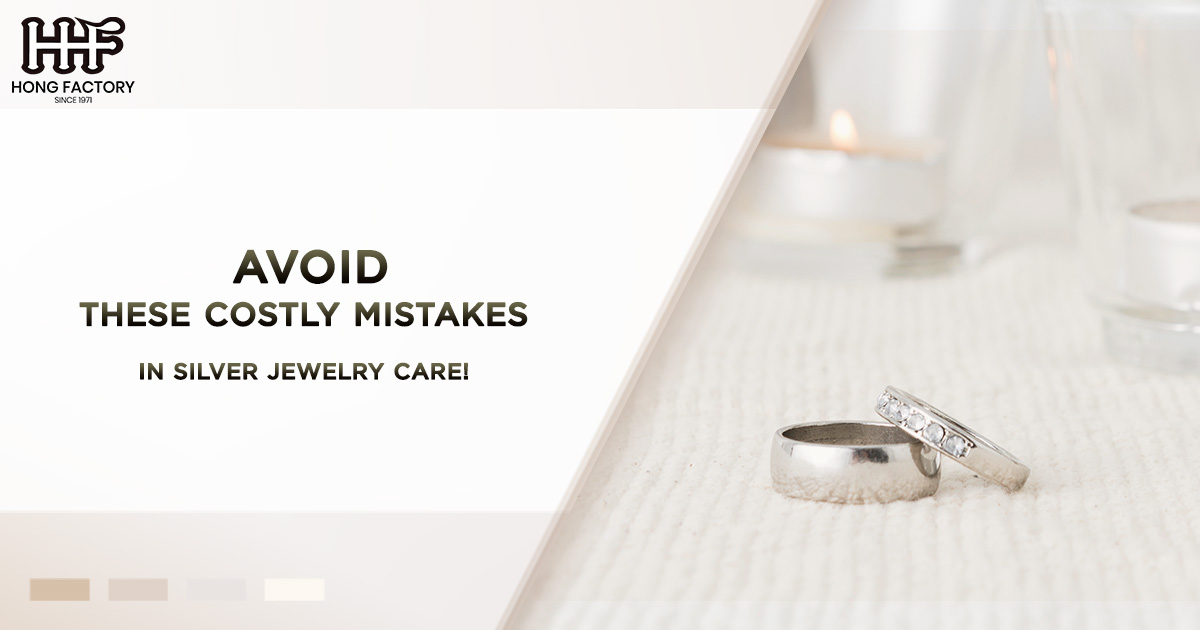Silver jewelry is prized for its timeless beauty and versatility, making it a favorite choice for many. However, silver is also a delicate metal that can tarnish, scratch, and lose its luster if not properly maintained. To preserve the beauty of your silver pieces, it’s crucial to follow the right care practices. Unfortunately, many people unknowingly make mistakes that can cause unnecessary jewelry damage, leading to loss of value and aesthetic appeal. In this article, we will highlight what not to do when cleaning and storing silver jewelry, and how to avoid common cleaning mistakes and maintenance errors.
Common Mistakes When Cleaning Silver Jewelry
Cleaning silver jewelry might seem straightforward, but there are several pitfalls you need to avoid to ensure your jewelry remains beautiful for years to come. Here are some cleaning mistakes that can lead to jewelry damage:
1. Using Harsh Chemicals
One of the most common mistakes people make when cleaning silver jewelry is using harsh chemicals. Products that contain ammonia, bleach, or other strong cleaning agents can strip away the silver’s natural sheen and cause long-term damage. These chemicals can also accelerate tarnishing and erode the protective layer of your jewelry, leading to permanent discoloration.
What to Do Instead
Opt for gentler cleaning methods, such as using a mild soap diluted in warm water. You can also invest in a silver-specific cleaning solution that is formulated to remove tarnish without damaging the metal. Always read the labels of any cleaning products to ensure they are safe for use on silver.
2. Scrubbing Too Hard
It can be tempting to scrub vigorously when trying to remove tarnish or dirt, but this can cause more harm than good. Scrubbing too hard can lead to scratches and dullness, especially if you’re using abrasive materials like scouring pads or stiff-bristled brushes.
What to Do Instead
Use a soft, non-abrasive cloth or a microfiber jewelry cloth. Gently rub the surface of the silver in a circular motion, focusing on one small area at a time. For intricate or detailed pieces, use a soft-bristled toothbrush to reach crevices, but be sure to apply minimal pressure.
3. Soaking Silver Jewelry in Water for Too Long
Soaking silver jewelry for extended periods may seem like a good way to loosen dirt and tarnish, but it can actually cause silver to become discolored or damaged. Water can seep into small cracks and crevices, leading to tarnish or corrosion over time. Additionally, soaking silver jewelry with gemstones can damage the stones or loosen their settings.
What to Do Instead
Limit soaking time to a few minutes, especially for delicate or detailed pieces. After soaking, immediately dry the jewelry with a soft cloth to prevent water spots or tarnish from forming. If your silver jewelry contains gemstones, it’s best to avoid soaking altogether and instead use a damp cloth to gently clean the metal.
4. Using Toothpaste or Baking Soda
Toothpaste and baking soda are often touted as DIY silver cleaners, but they can actually do more harm than good. While these abrasive substances may effectively remove tarnish, they can also scratch the surface of your silver, especially if it’s a high-polish or delicate piece.
What to Do Instead
Use a commercial silver polish or a specialized silver-cleaning cloth. These products are designed to clean silver without causing scratches. If you prefer a DIY approach, create a gentle cleaning solution using a mixture of mild dish soap and water, or use a paste made from cornstarch and water.
5. Ignoring Tarnish Prevention
Silver naturally tarnishes over time, but failing to take preventive measures can accelerate the process. Exposure to air, moisture, and certain chemicals can cause silver to tarnish more quickly, leaving it looking dull and discolored.
What to Do Instead
Store your silver jewelry in an airtight container or a tarnish-resistant jewelry box to minimize exposure to air and humidity. You can also place anti-tarnish strips or silica gel packs inside the storage box to absorb excess moisture. Regularly cleaning and polishing your silver jewelry can also help slow down the tarnishing process.
Errors in Storing Silver Jewelry
Improper storage can be just as damaging to silver jewelry as incorrect cleaning methods. Many people unknowingly make maintenance errors when storing their silver pieces, leading to scratches, tarnishing, and even deformation. Here are some key points to keep in mind:
1. Storing Silver Jewelry in an Open Air Environment
Leaving silver jewelry out in the open can lead to rapid tarnishing due to contact with oxygen and moisture. Storing silver in a humid environment, such as a bathroom, can also speed up tarnishing and lead to corrosion over time.
What to Do Instead
Store your silver jewelry in a cool, dry place, away from direct sunlight and humidity. Consider using airtight containers, zip-lock bags, or jewelry boxes with anti-tarnish lining. If you live in an area with high humidity, adding silica gel packets to your jewelry storage can help absorb excess moisture.
2. Storing Different Metals Together
Another maintenance error is storing silver jewelry alongside other metals, such as gold, platinum, or stainless steel. Different metals can react with one another, leading to scratches, tarnishing, and discoloration. Silver is particularly soft and prone to damage when in contact with harder metals.
What to Do Instead
Store each piece of silver jewelry separately, either in individual pouches, soft cloth bags, or lined compartments inside a jewelry box. This prevents metals from rubbing against each other and minimizes the risk of scratches and tarnishing.
3. Hanging Silver Necklaces
While it may seem convenient to hang silver necklaces to avoid tangling, this practice can actually cause the chains to stretch or weaken over time. Additionally, hanging necklaces can expose them to air and dust, leading to tarnish.
What to Do Instead
Lay necklaces flat in a jewelry box or drawer, or store them in individual pouches to prevent tangling and stretching. If you prefer to hang your necklaces, make sure they are in a closed jewelry cabinet that protects them from air exposure.
4. Forgetting to Clean Before Storage

One of the most overlooked maintenance errors is putting away silver jewelry without cleaning it first. Dirt, oils, and sweat from your skin can accelerate tarnishing if left on the jewelry for extended periods. Failing to clean your silver before storage can also make it harder to clean later on.
What to Do Instead
Before storing your silver jewelry, gently clean it with a soft cloth to remove any dirt, oils, or moisture. For pieces that are worn frequently, a quick wipe-down after each use is a good practice to keep them in pristine condition.
5. Overcrowding Jewelry Storage
Jamming multiple pieces of jewelry into a single compartment or box can lead to scratches, tangling, and other forms of jewelry damage. Silver is a soft metal, and when it comes into contact with other pieces, it can easily become scratched or deformed.
What to Do Instead
Avoid overcrowding your jewelry storage. Make sure each piece has enough space to rest without rubbing against other items. Use padded dividers or individual pouches to keep each piece separate and protected.
Conclusion
Maintaining the beauty of your silver jewelry doesn’t have to be difficult, but it does require attention to detail and care. By avoiding these common cleaning mistakes and maintenance errors, you can prevent unnecessary jewelry damage and keep your silver pieces looking stunning for years to come. Remember to use gentle cleaning products, store your silver properly, and regularly polish your jewelry to maintain its shine. With the right care, your silver jewelry will remain a lasting treasure.





